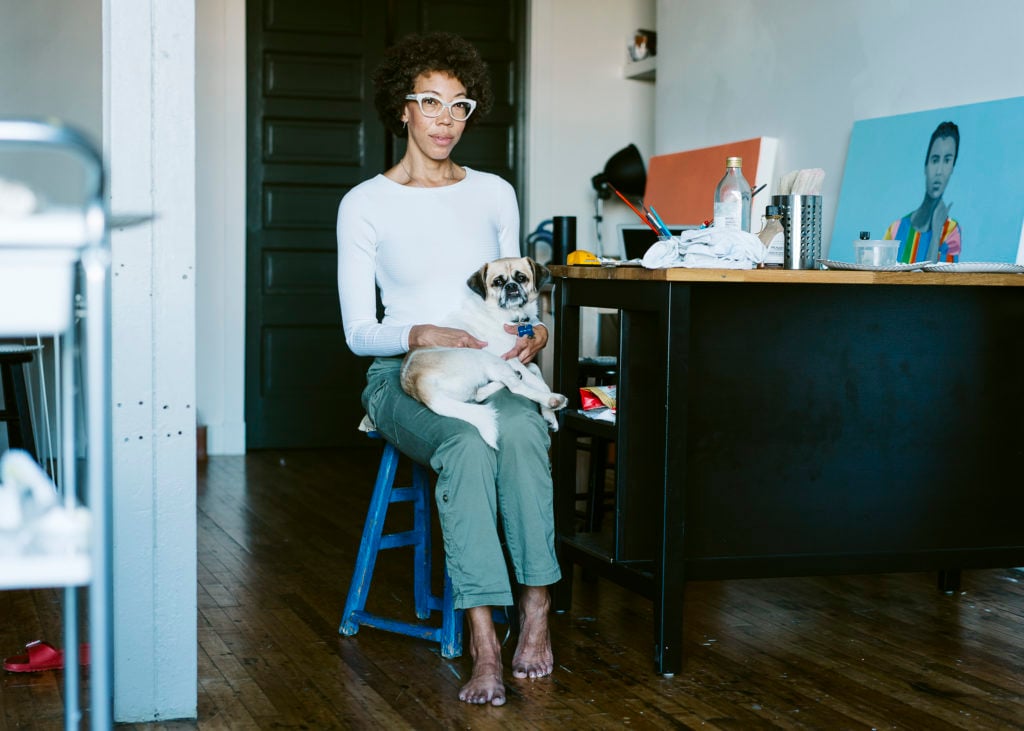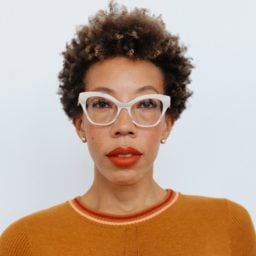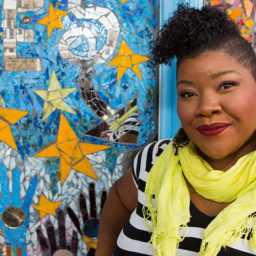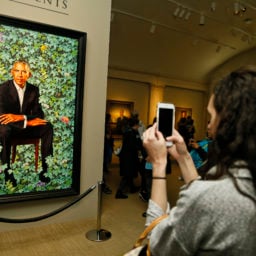Before October 13, 2017—the day she was named, along with Kehinde Wiley, as one of the artists chosen to paint the Obamas’ official portraits—few outside the art world cognoscenti had heard of Amy Sherald.
That all changed in February when the paintings were unveiled at the Smithsonian’s National Portrait Gallery in Washington, DC. Immediately, the images became a sensation, spreading across the Internet like wildfire and boosting attendance at the museum by a staggering 300 percent. Sherald’s sudden rise seemed meteoric and has largely been presented that way by the press.
But the 44-year-old artist wants to make one thing clear: It took many years of hard work for her to become what many have considered an overnight sensation.
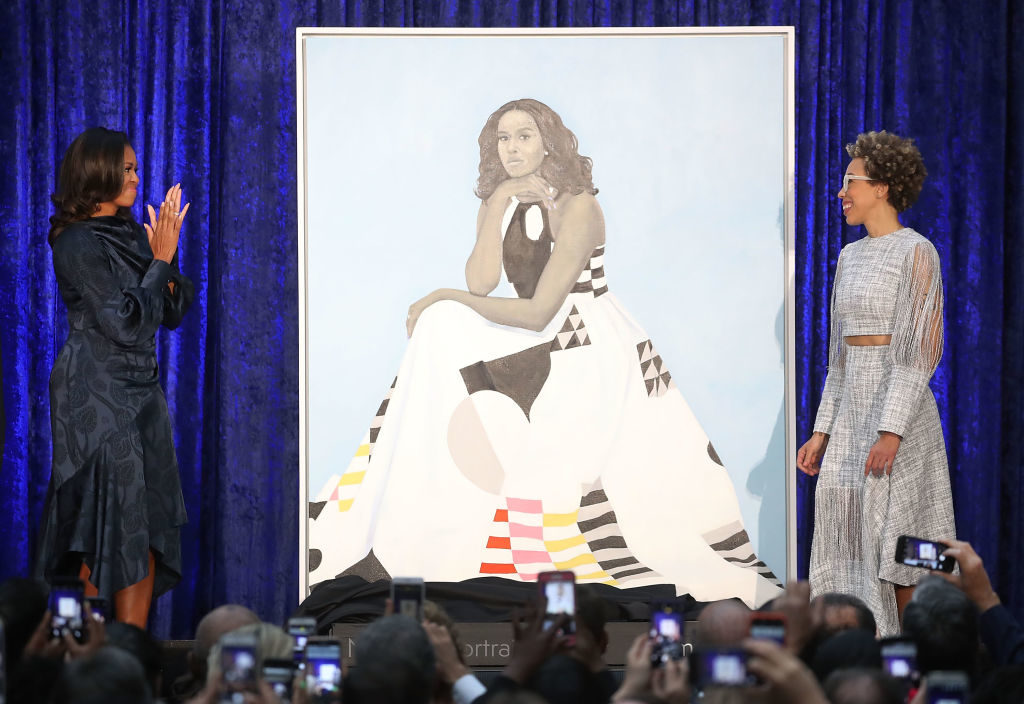
Former U.S. first lady Michelle Obama (L) and artist Amy Sherald unveil her portrait at the Smithsonian’s National Portrait Gallery. Photo by Mark Wilson/Getty Images.
“I had a career before Michelle Obama,” Sherald assured artnet News. “I think the last artnet article said I started painting in earnest when I was 42, which was complete bullshit.”
Much has been made of her winding path to art stardom, which was diverted by a 2012 heart transplant and years spent caring for ill family members. But Sherald wanted to clarify that her career was not greatly disrupted by her own surgery. In fact, she took a mere eight months off for recovery.
“I was painting up until the day I went into the hospital. It wasn’t like I had heart failure and I wasn’t getting work done,” Sherald said, noting that she was also waiting tables at the time. “There’s been a lot of work that has not been accounted for, because for some reason the media wants to make it sound like it was a beautiful miracle, that I have a career now out of the blue—but no, it’s just from plain old perseverance.”
Even before her portrait of the former First Lady went viral—to accommodate the crowds, the museum had to move the painting to a bigger room—she was preparing for her first museum solo show, which opened at the Contemporary Art Museum Saint Louis last month.
That didn’t come out of nowhere, either: After her first major gallery exhibition at Chicago’s Monique Meloche Gallery in 2016, there was already a waiting list of some 50 to 60 people, including institutions, eager to buy her work.
When we spoke to the Georgia-born, Baltimore-based artist, she had just shipped off the final batch of paintings for the CAM show, putting an end to what she described as “a crazy three years of non-stop work.” (Immediately after mailing them off, “I came home at 11 a.m., had a margarita, sat on the couch, and fell asleep for seven hours,” she said.)
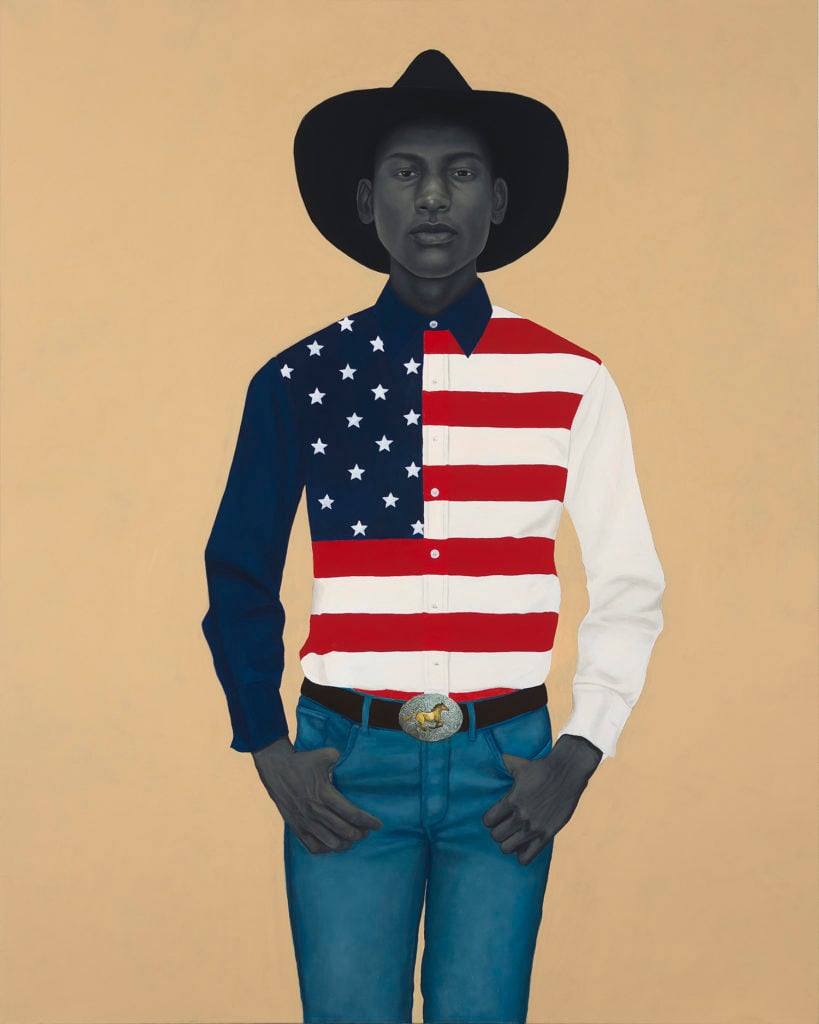
Amy Sherald, What’s precious inside of him does not care to be known by the mind in ways that diminish its presence (All American), 2017. Courtesy of the artist and Hauser & Wirth, ©Amy Sherald.
In a rare moment of pause, artnet News spoke to Sherald about her daily routine, early inspirations, new directions in her work, and the importance of leaving behind a legacy.
What have your days been like in the studio, preparing for the show?
I usually get there around 10:30 in the morning, and I leave around 10. I answer some emails and I chat with my assistant about what needs to happen. I read for about 30 minutes and then I start working. The reading settles my mind and me gets me focused. I listen to podcasts while I work. I only stop to eat and to take my dog out. I needed a dog because I was never getting outside!
What can viewers expect from the show?
I made the work that I could with the time that I had—I didn’t know how the unveiling was going to blow over into the rest of my life for weeks and weeks and weeks afterward. There are two new paintings.
One big piece is kind of a turning point. It’s a really large, multi-figured painting, set outside, so it’s different from anything I’ve ever done before. It’s something I’ve wanted to do, but bigger paintings require a lot of time and I’ve had a lot of deadlines over the past three years.
Those kinds of things, people take for granted. In the beginning of your career, your paintings could be selling for $8,000, $10,000, $12,000, but you’re only making half of that. If you’re producing 10 or 11 paintings a year, that’s not that much money given living expenses, plus studio expenses, and things like that.
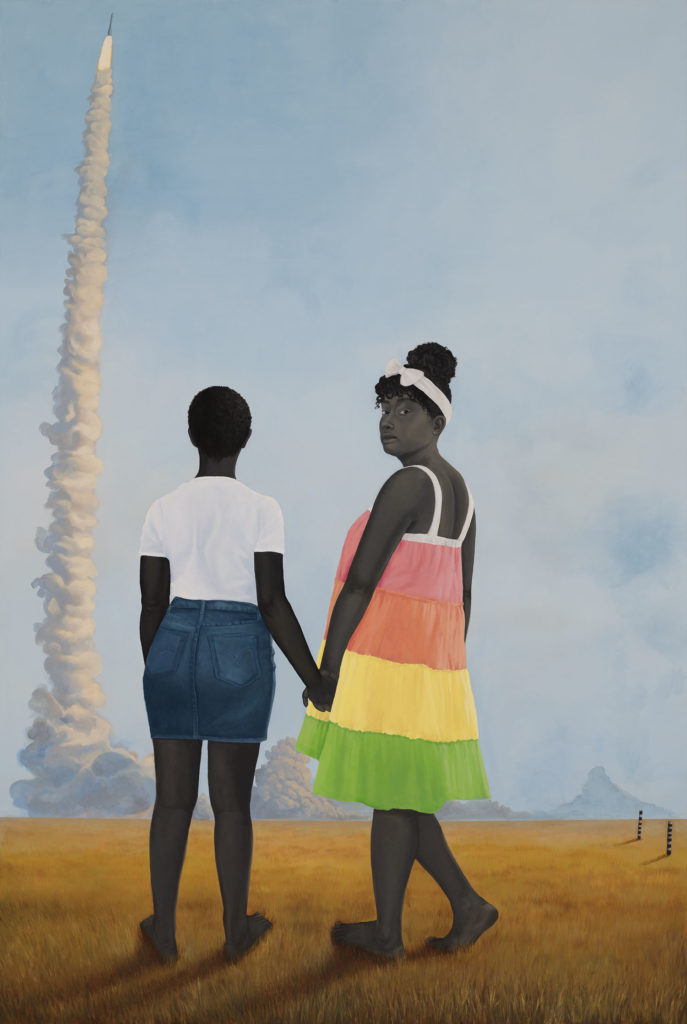
Amy Sherald, Planes, rockets, and the spaces in between (2018). Courtesy of the artist and Hauser & Wirth, ©Amy Sherald.
How did you first develop your distinctive visual language, with grayscale skin tones?
It was kind of by accident. I had started a painting, and I was going to do glazes of brown over the gray. But then I decided not to, because It looked beautiful the way that it was. The commentary and the discourse, that comes afterwards; it wasn’t in my head at that moment.
When I think about my work, the vision is first. I think composition and color, the formal aspects of paintings—I’m assuming other artists are like this too. Once you finish something and look back at what you did, you can see things there that have meaning or are critiquing something.
Will you continue to paint people you see in the street who inspire you, or will you do more commissioned portraits of specific subjects?
I’m going to continue to paint in the same way. If there is somebody who comes along who I just can’t turn down because I really want to paint them, that’s one thing, but I’m definitely not a commissioned artist.
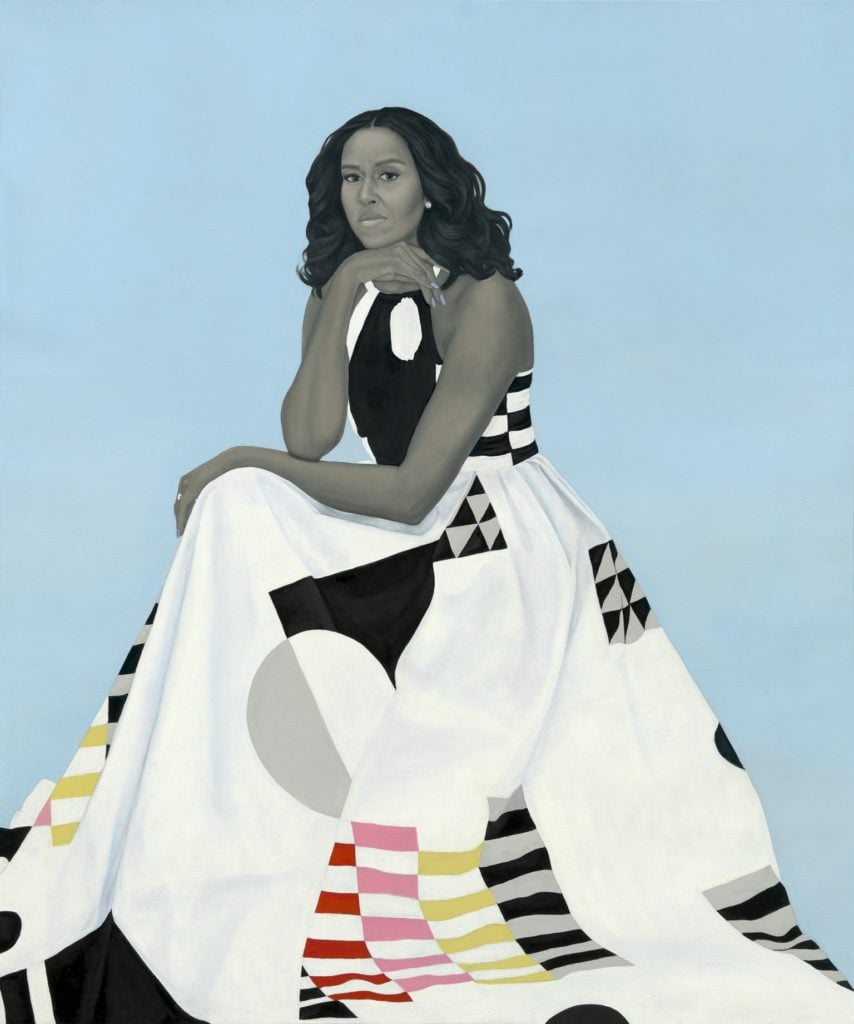
Amy Sherald, Michelle LaVaughn Robinson Obama (2018). Courtesy of the National Portrait Gallery, Smithsonian Institution.
What was it like painting Michelle?
There were funny things that happened. We had two photo sessions in 2017, in May and October. The second time, we were outside and it had just rained. There were little balls of gnats flying around and they kept coming near her. Everybody was trying to gently fan so the bugs would go away. She was good sport!
She’s very authentic so it kind of takes away any feeling of nervousness because she doesn’t come into situations like, “I’m the former First Lady.” It’s just like, “Hey, y’all.”
Has anything strange happened since the Michelle Obama painting went viral?
Somehow people have gotten my home address, and I’ve gotten these random letters from all over America with newspaper articles that people want me to sign. I don’t know whether to do it or not!
I came home one day and my concierge told me two women had driven all the way from Savannah to show me a portrait that they made of me looking like one of my paintings. They didn’t email me, they just jumped in their car. He didn’t tell them whether I lived there or not, so they went outside and they were showing people my picture, asking, “Have you seen this woman, does she live here?” That was kind of weird, too.
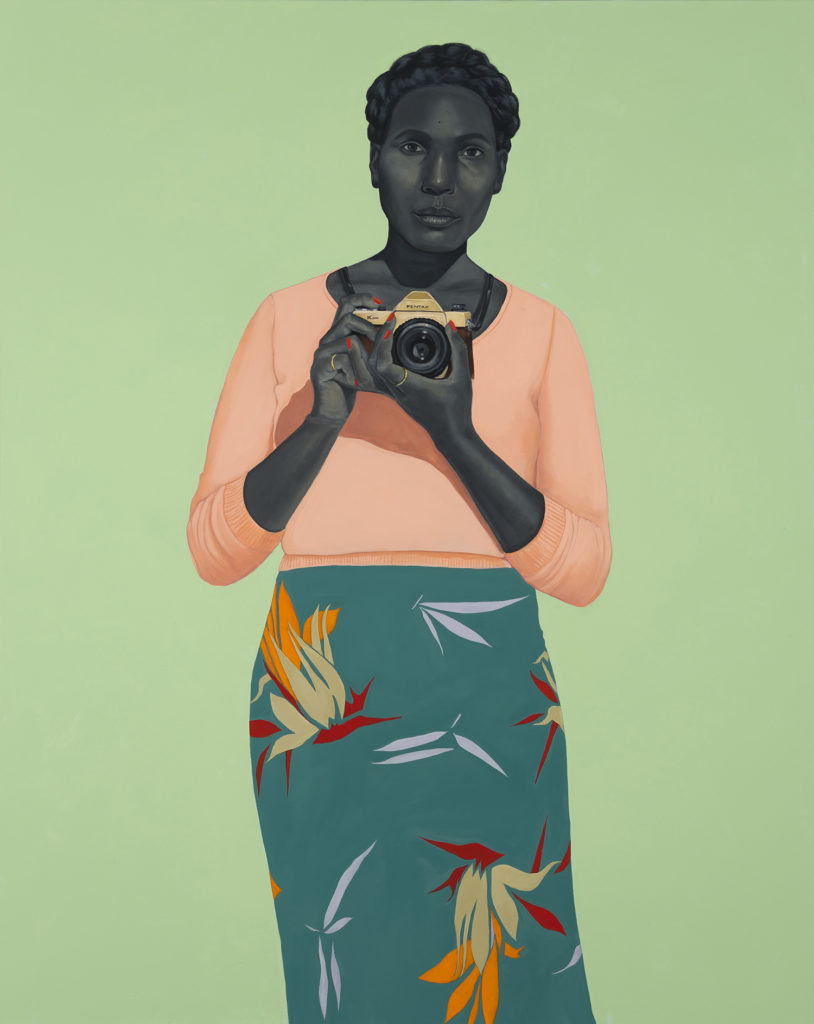
Amy Sherald, What’s different about Alice is that she has the most incisive way of telling the truth (2017). Courtesy of the artist and Hauser & Wirth, ©Amy Sherald.
Do you feel any different personally?
It did boost my confidence, only because I had been struggling for the longest time. You know you’re going to make it—everything was starting to fall into place—but it does kind of wear down on you when you’re in your 40s and you need to borrow money from somebody. You get these feelings of shame.
There is so much that you go through as an artist just trying to make it. You can have a beautiful body of work in your studio, but at the end of the day it doesn’t matter if you can’t eat. I think I walk a little straighter now.
Everything happened at the same time. I got the unveiling and I met my life partner all within six months. I feel more ready and confident.
What has been the biggest adjustment for you, in the wake of the unveiling?
It has pushed me out into the mainstream. Suddenly people who don’t know a lot about art know who I am. People may know me, but they won’t know someone they should know, like Kerry James Marshall or David Driskell, who have huge careers.
Kids know who I am now, which is really exciting. That’s been the most special thing about it. I went to visit a school here in Baltimore and the kids were excited, as if I were a basketball player. It’s amazing to have sixth graders squealing because you’re in the classroom and you’re an artist. It’s opening up their minds about things they can or cannot do to make a living.
I have at least 100 pictures of kids who’ve done portraits like my portraits. They’re learning in art class about portraiture through my portraiture, which is special, because I had to learn about portraiture through European painting. Those were images that I couldn’t exactly relate to. Kids can look at my work and see somebody who looks like them and be empowered by that. I’ve gotten a lot of letters from kids who are interested in the arts, or who weren’t interested in art and are now engaging on a deeper level.
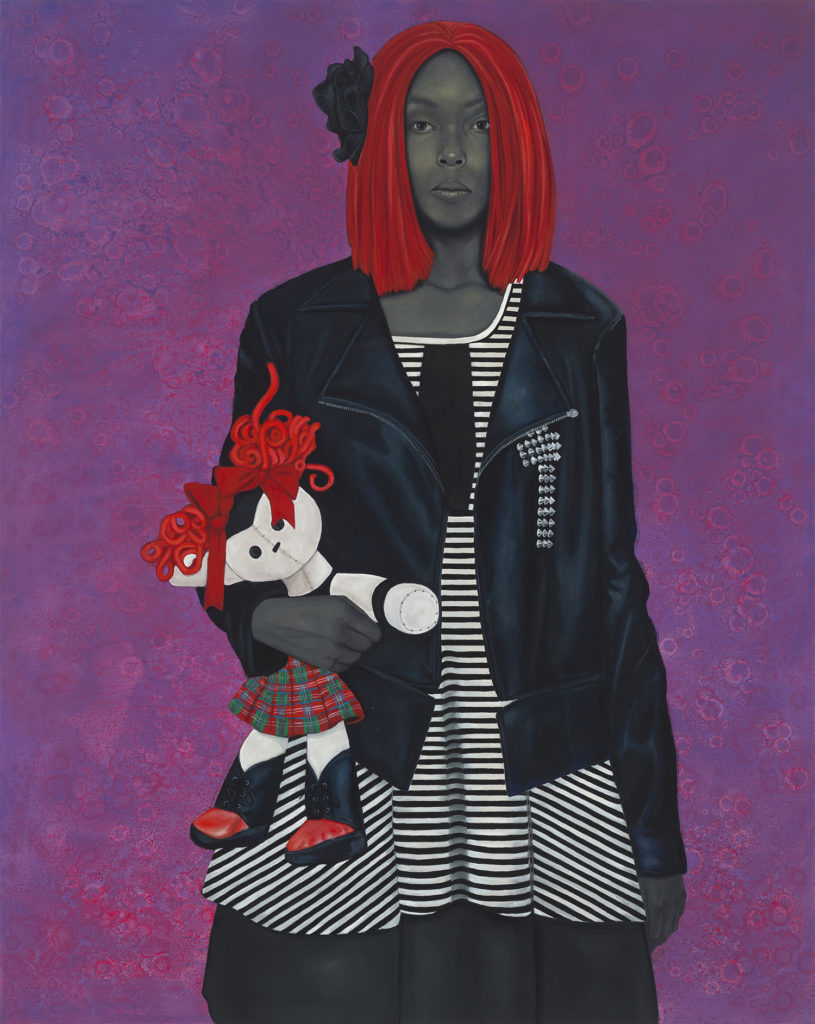
Amy Sherald, Freeing Herself Was One Thing, Taking Ownership of that Freed Self Was Another (2015). Courtesy of the artist and Hauser & Wirth, ©Amy Sherald.
What is your advice for young people pursuing a career as an artist?
Set up your life so that your studio practice always comes first. And don’t compare your journey to anybody else’s. Focus on what you need to do, because your path is your path. I’m a late bloomer, but I learned so much by watching other people’s careers blossom years before me. You kind of check out everybody’s mistakes and avoid making them yourself.
As a young person, how did you learn about art?
I had encyclopedias—that’s all I had. I didn’t have any black artists to look up to growing up. For me, it’s been important from the beginning that the works that I’ve made ended up in museums, so kids can see people who look like them in institutions. It’s kind of pointless for me otherwise.
The first contemporary artist I saw was Bo Bartlett. On a field trip in the sixth grade, I saw his painting Object Permanence, a portrait of himself as a black man. It really resonated with me, because I had never seen a painting of a black person before.
He paints these narratives, realist pictures of everyday people doing everyday things. Nobody is going to try and read anything into it or make it about white male identity or any of that stuff. Similarly, my work can be employed in different ways, and I like it to sit in all kind of places, but I also need it just to be paintings of everyday black people just being themselves. I say that I paint America.
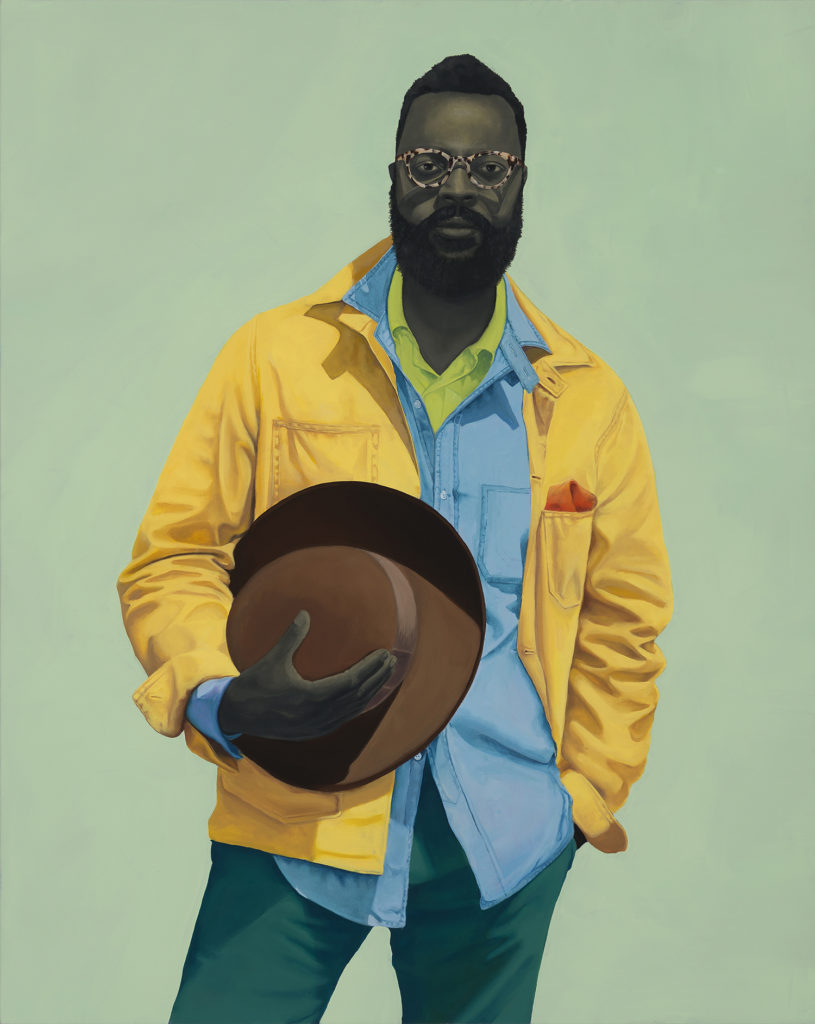
Amy Sherald, Pythagore (2016). Courtesy of the artist and Hauser & Wirth, ©Amy Sherald.
Had you ever imagined creating such a high-profile work that would elicit such a great response from the public?
No! I know Kehinde had dreamed of painting Barack, but [a presidential commission] wasn’t even in my realm of things to think about. He had already painted Michael Jackson, so of course it’s like, “What’s next? Obama.”
I had never considered it. I knew I was going to be successful. I knew I wasn’t going to have to worry about eating, and I would be able to pay my bills and school loans. I thought, well, “I’ll get a gallery, I’ll sell a few hundred thousand dollars a year worth of art, and that’ll be my life.” I never imagined it could be like this. I had given myself my own glass ceiling in a way.
And now you’ve signed with Hauser & Wirth.
I was asking [fellow artist] Mark Bradford for advice about another gallery that had been interested in me. He really loves my work, and is represented by Hauser & Wirth. He thought that they would be a good place for me to be, so he made the introduction.

Amy Sherald, fact was she knew more about them than she knew about herself, having never had the map to discover what she was like (2015). Courtesy of the artist and Hauser & Wirth, ©Amy Sherald.
As a professional artist, have you developed close relationships with other black artists?
It’s nice. We’re all just really generous with each other. When Theaster Gates started having the black artists’ retreats, that was the first time I was able to meet all these people whose work I had seen and admired. It’s a beautiful thing to be there and talk about our experiences and careers. Everybody is really willing to be helpful in any way that we can. We’re all in it together.
Are you allowing yourself to dream bigger now? What are your goals moving forward, now that you’ve shattered that glass ceiling?
It’s wonderful to have the opportunity to leave behind an even greater legacy than I could have ever dreamed I could leave behind.
I really want to make some of the gains that I see my cohort making like Rashid Johnson and Mark Bradford. I’m always… I don’t know what I should say in public or not.
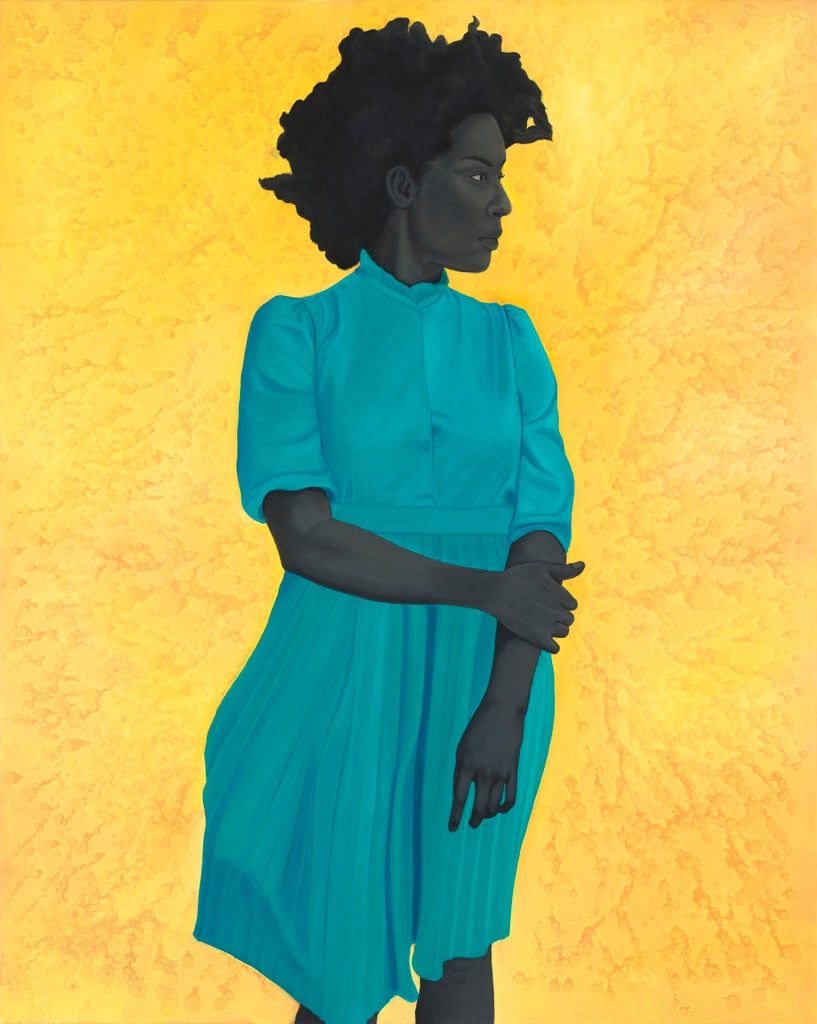
Amy Sherald, Saint Woman (2015). Courtesy of the artist and Hauser & Wirth, ©Amy Sherald.
I think it’s okay to be ambitious and to have high expectations and goals. I don’t feel like women should feel ashamed of that—if you want something you should be able to say it.
Before talking to Mark, I didn’t know his work was selling works for millions of dollars. That was eye-opening. For me, making it big was selling a painting for $200,000—that was what I thought was possible. Now I see that I can have anything that I want. I just have to pull my chair up to the table; I have to ask for it. So I want that.
I like the way that Mark’s put a lot back into the community. That’s the same kind of model that I want to have as far as my career is concerned. It’s great to make a lot of money, but I also want to make it for a reason. There are things that I want to do here in Baltimore, and back in my home town in Columbus, [Georgia], to try and leave the world a better place that I found it.
Do you plan to stay in Baltimore, or do you feel any pressure to move to New York or LA?
I don’t really succumb to pressure. I’m in my 40s now! My partner lives in New York, so we still haven’t figured out where we are going to live out the rest of our lives. But no matter what, I am going to keep a foot in Baltimore. I really love this city, I’m on the board of the Baltimore Museum of Art, and I have so much to do here. So right now, it’s Baltimore.
This interview has been edited and condensed for clarity.
See more of Sherald’s work below.
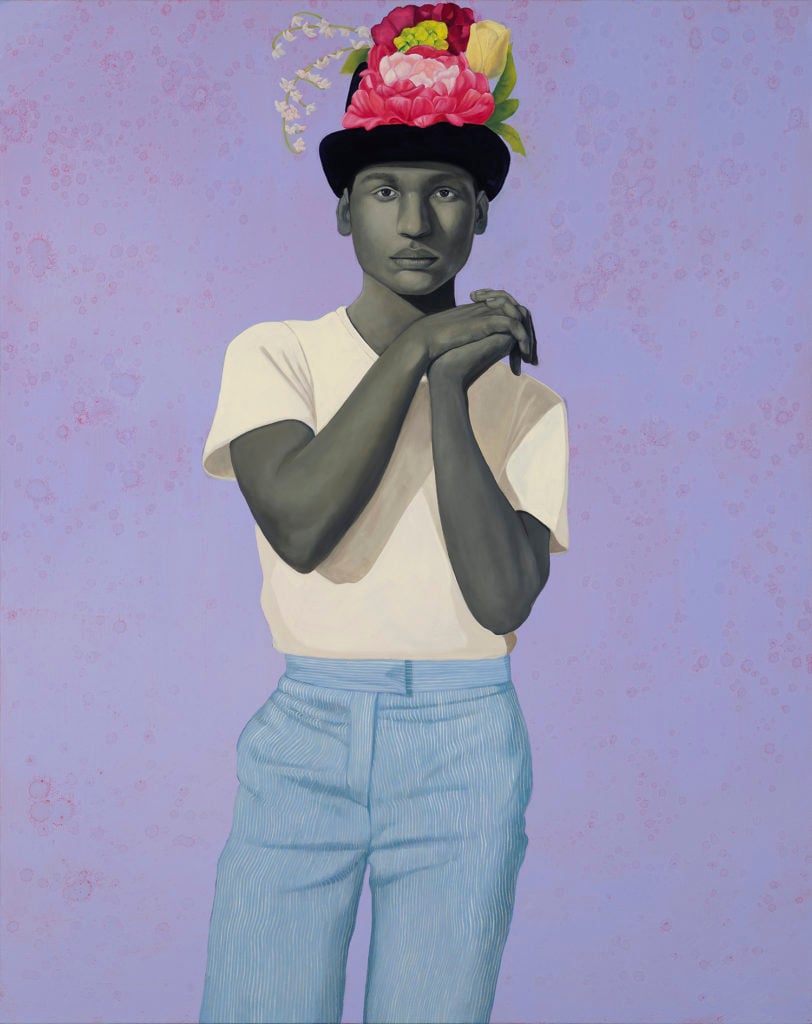
Amy Sherald, Try on dreams until I find the one that fits me. They all fit me. (2017). Courtesy of the artist and Hauser & Wirth, ©Amy Sherald.
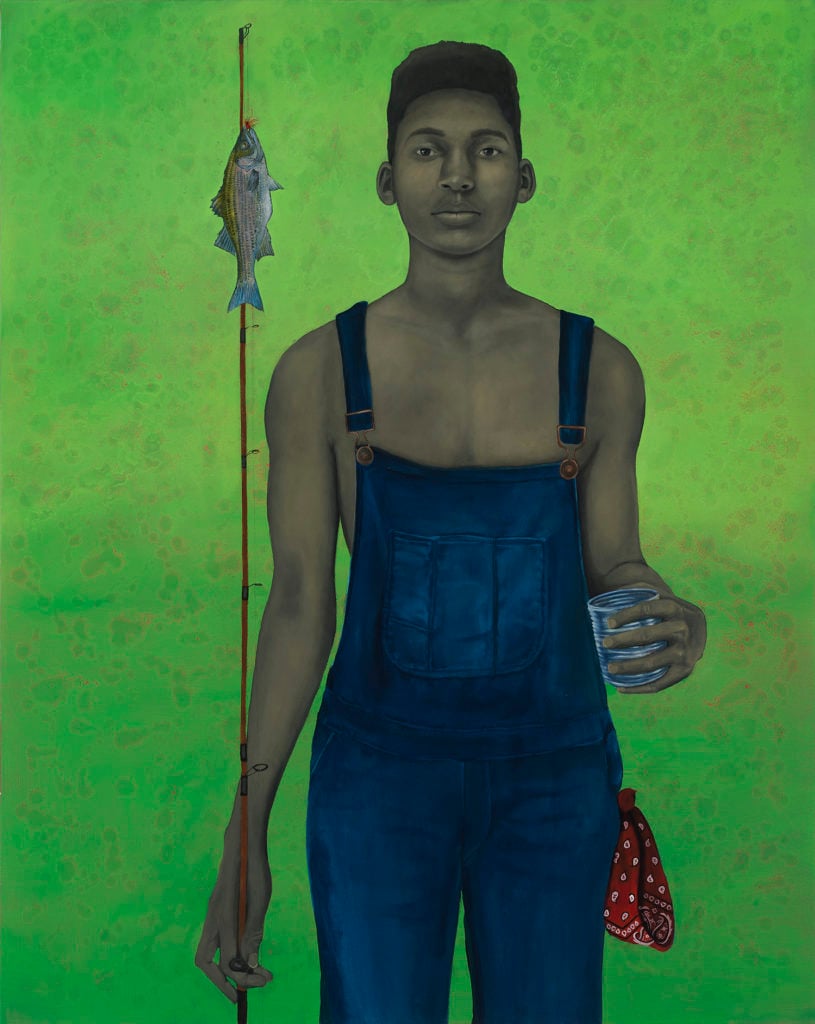
Amy Sherald, The Boy with the Big Fish (2016). Courtesy of the artist and Hauser & Wirth, ©Amy Sherald.
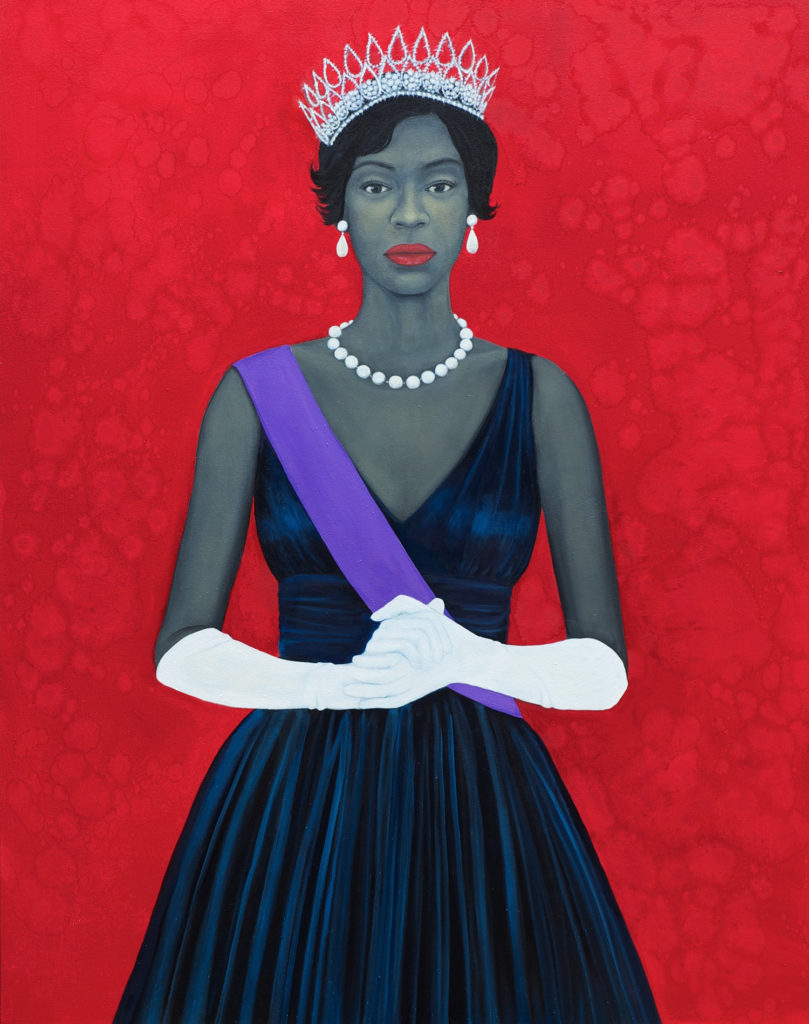
Amy Sherald, Welfare Queen (2012). Courtesy of the artist and Hauser & Wirth, ©Amy Sherald.
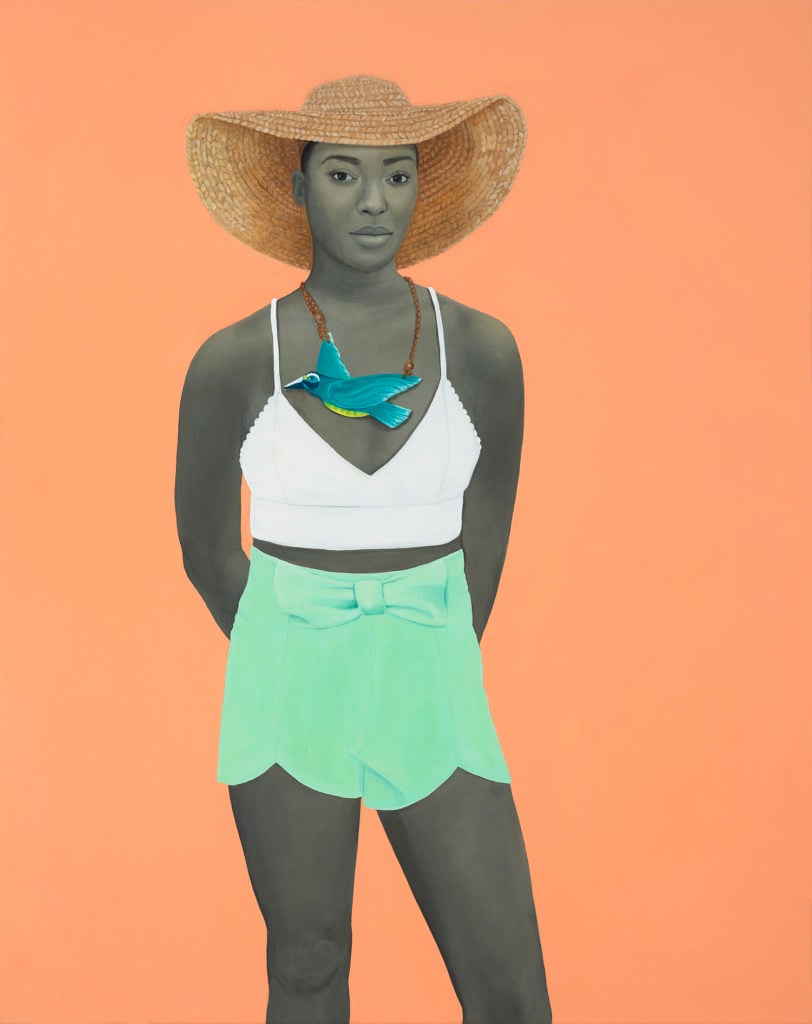
Amy Sherald, All the unforgotten bliss (The early bird), 2016. Courtesy of the artist and Hauser & Wirth, ©Amy Sherald.
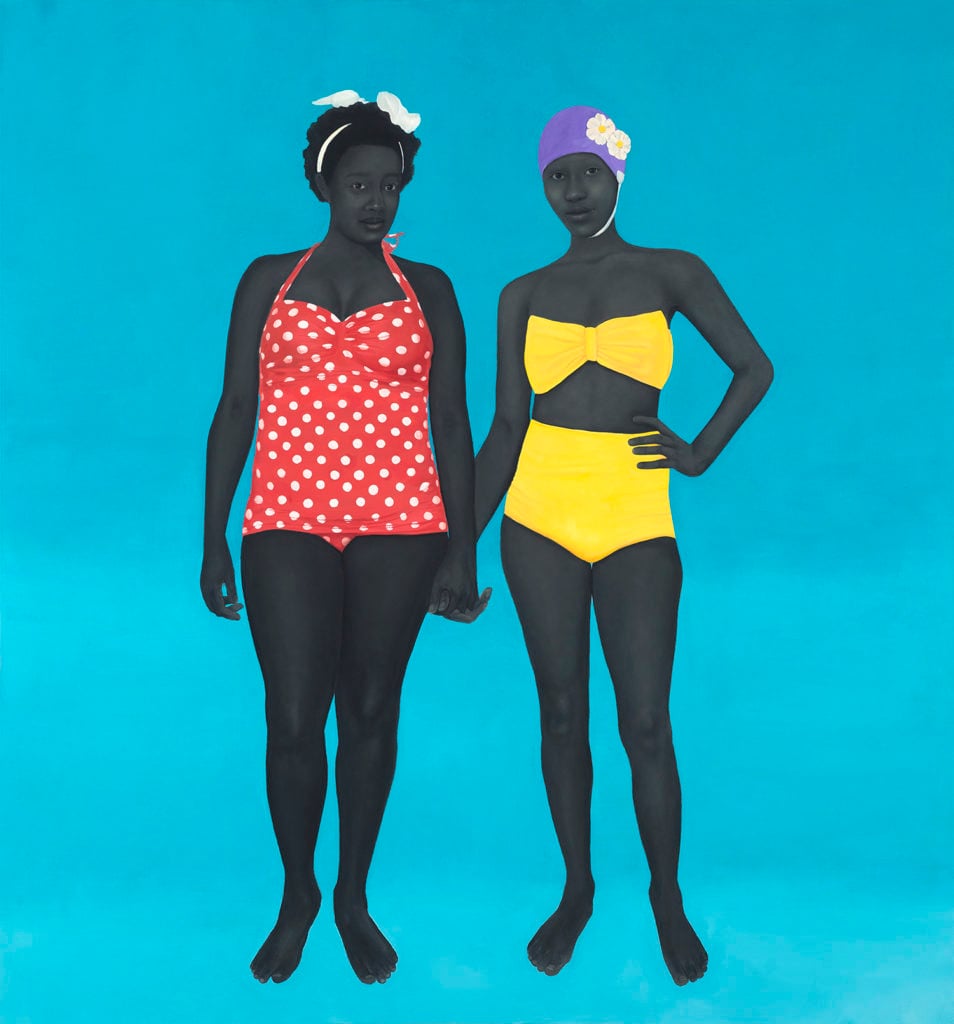
Amy Sherald, The Bathers (2015). Courtesy of the artist and Hauser & Wirth, ©Amy Sherald.
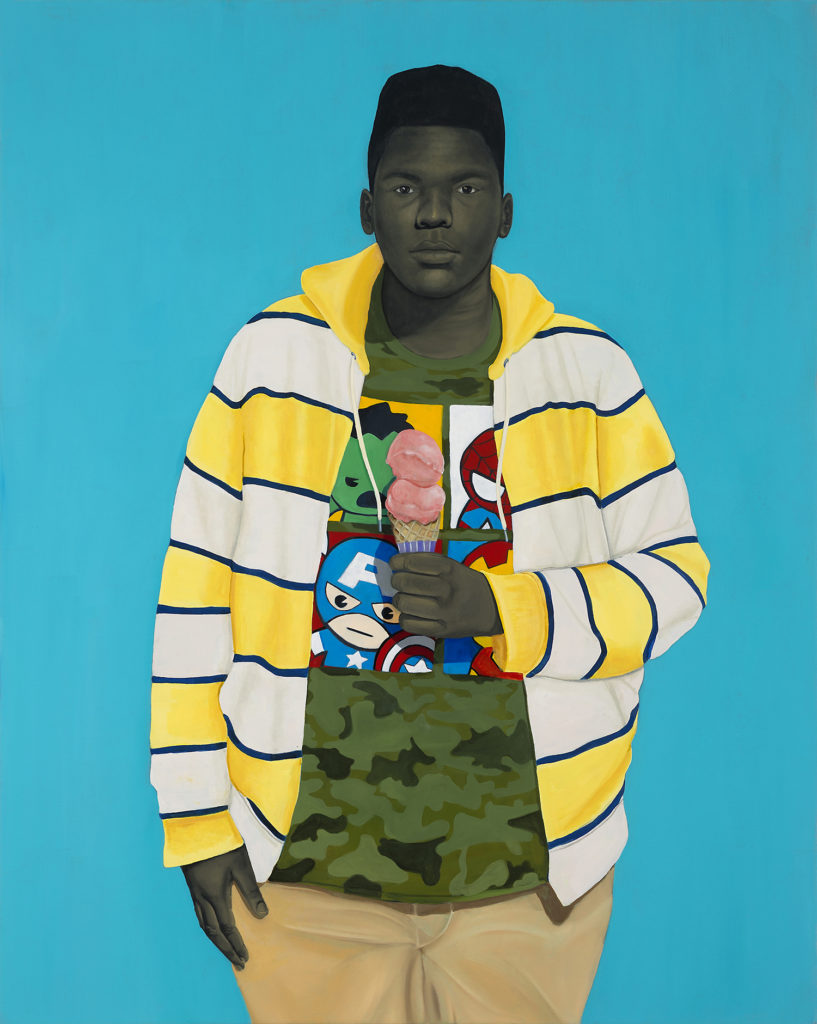
Amy Sherald, Innocent You, Innocent Me (2016). Courtesy of the artist and Hauser & Wirth, ©Amy Sherald.
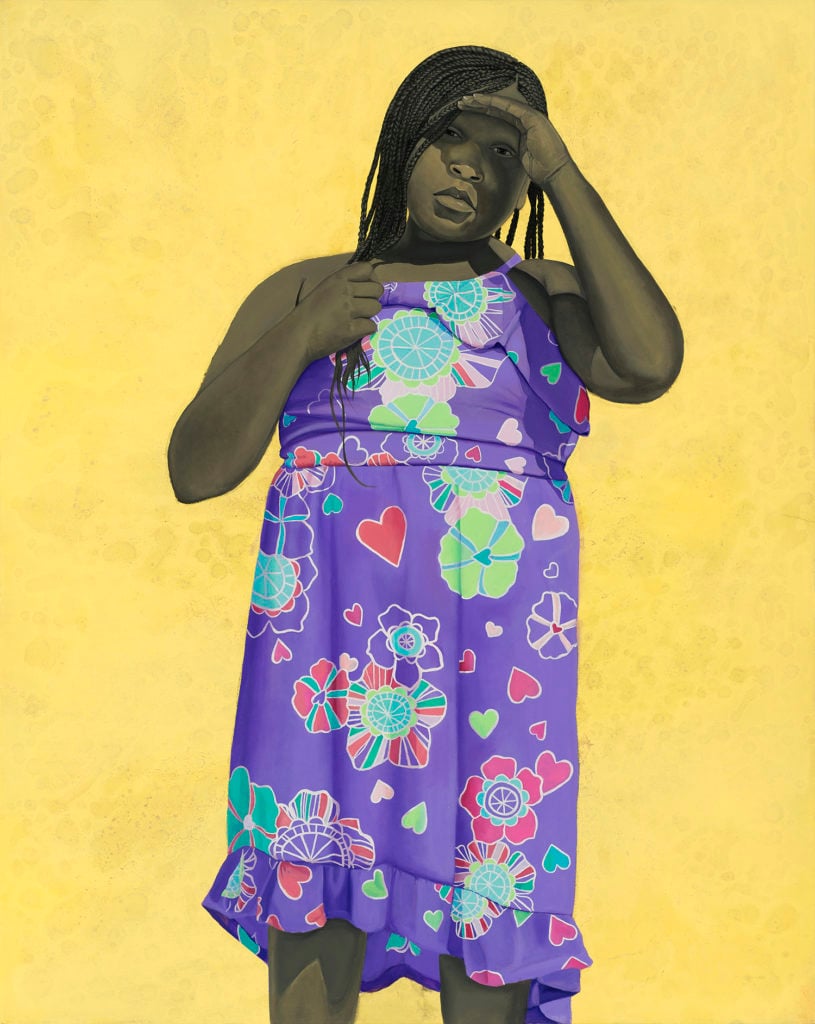
Amy Sherald, All Things Bright and Beautiful (2016). Courtesy of the artist and Hauser & Wirth, ©Amy Sherald.
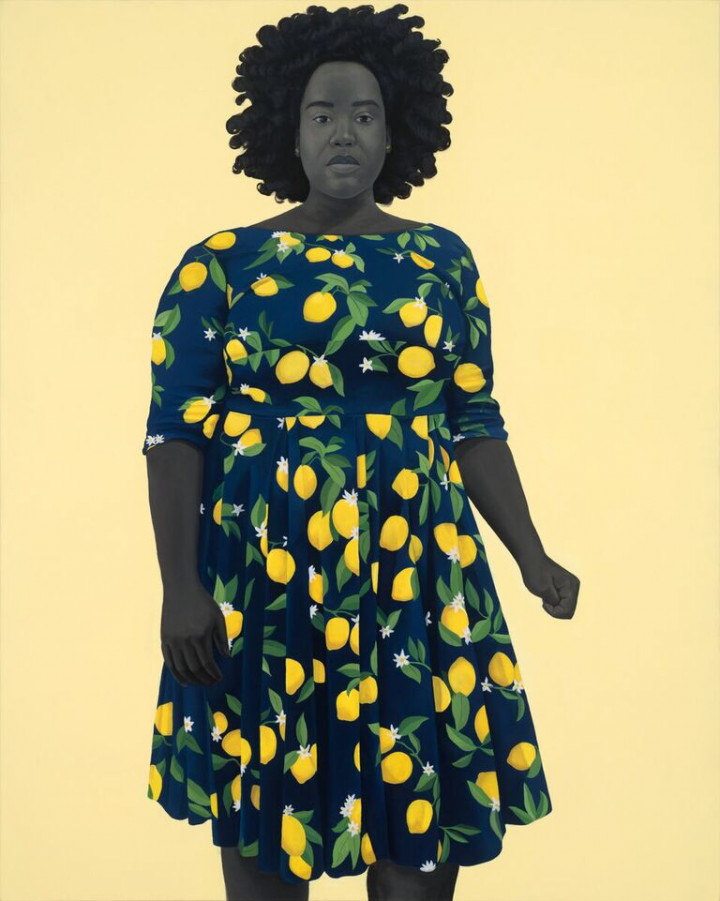
Amy Sherald, Untitled
(2018). Courtesy of the artist and Hauser & Wirth, ©Amy Sherald.
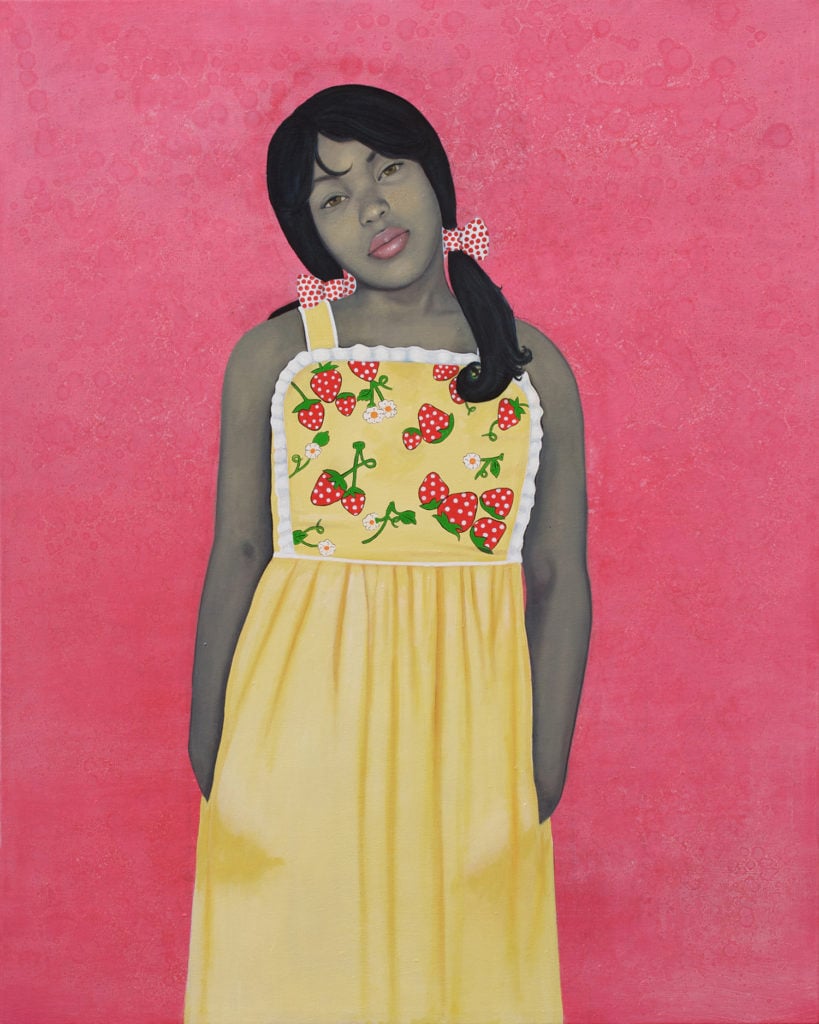
Amy Sherald, They Call Me Redbone, But I’d Rather Be Strawberry Shortcake (2009). Courtesy of the artist and Hauser & Wirth, ©Amy Sherald.
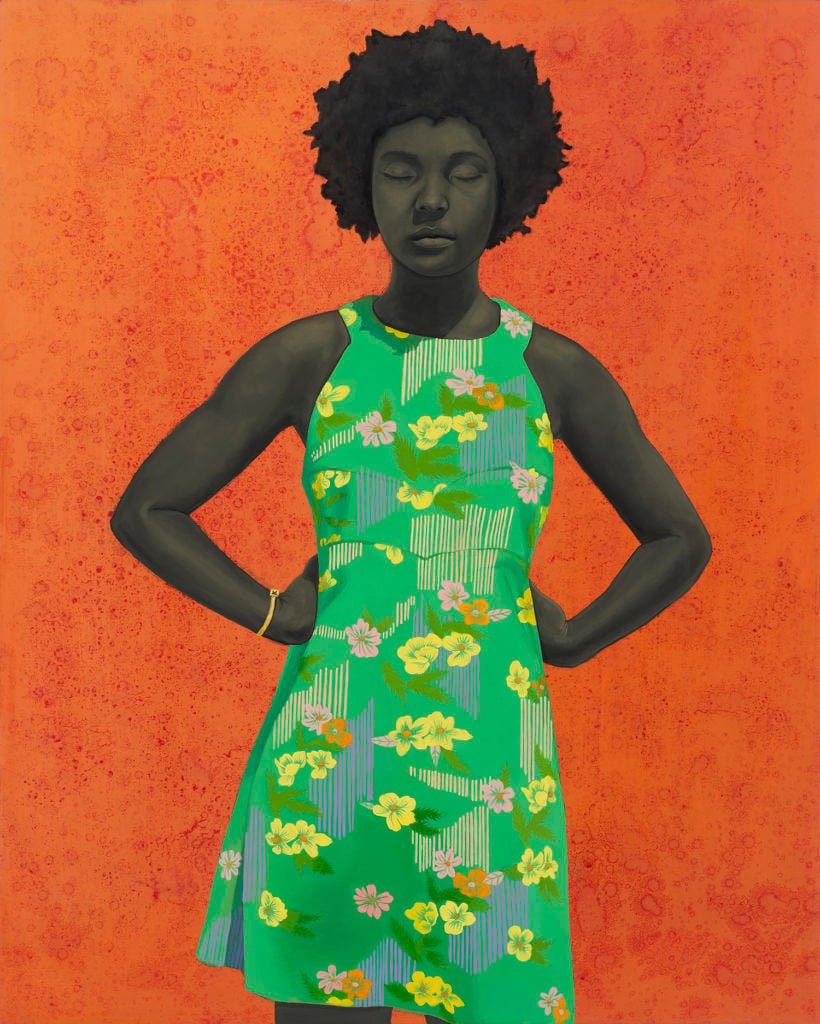
Amy Sherald, The Make Believer (Monet’s Garden), 2016. Courtesy of the artist and Hauser & Wirth, ©Amy Sherald.
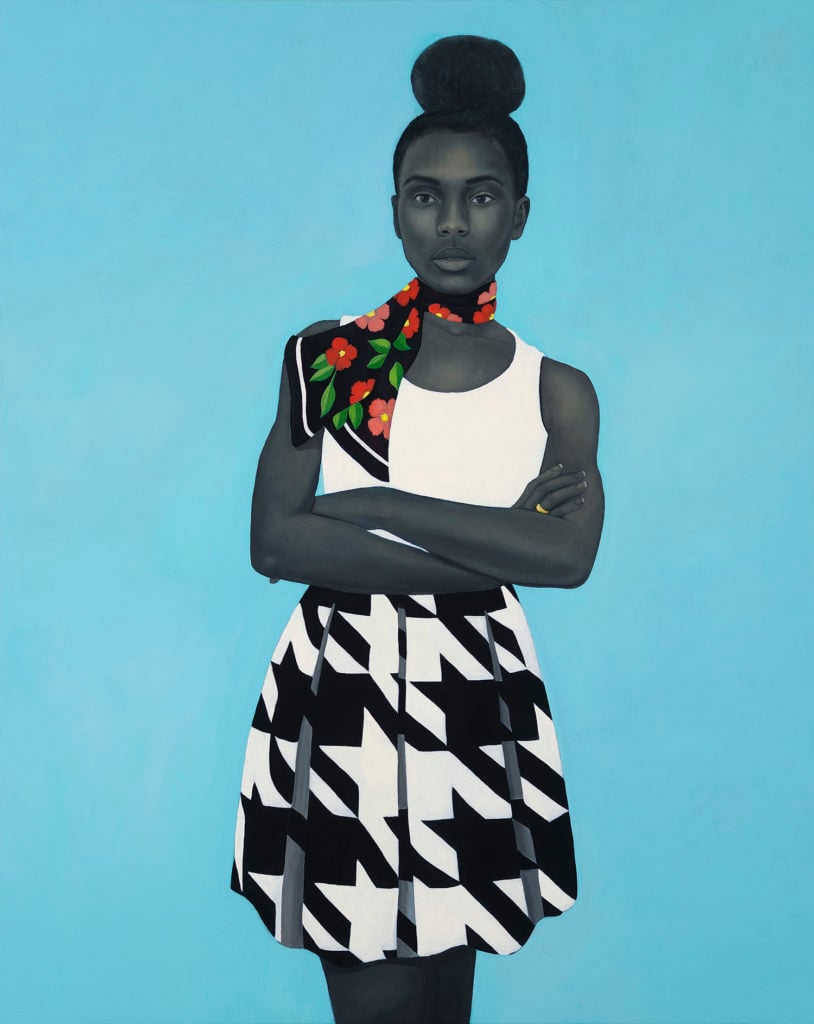
Amy Sherald, A clear unspoken granted magic (2017). Courtesy of the artist and Hauser & Wirth, ©Amy Sherald.
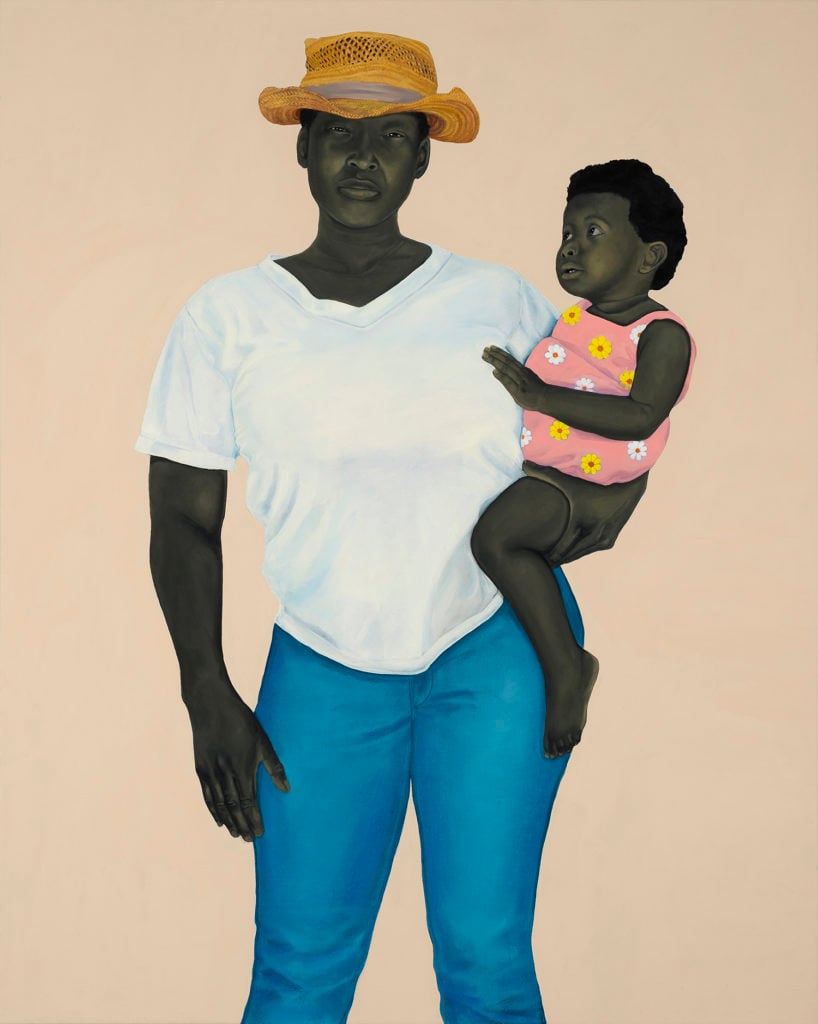
Amy Sherald, Mother and Child (2016). Courtesy of the artist and Hauser & Wirth, ©Amy Sherald.
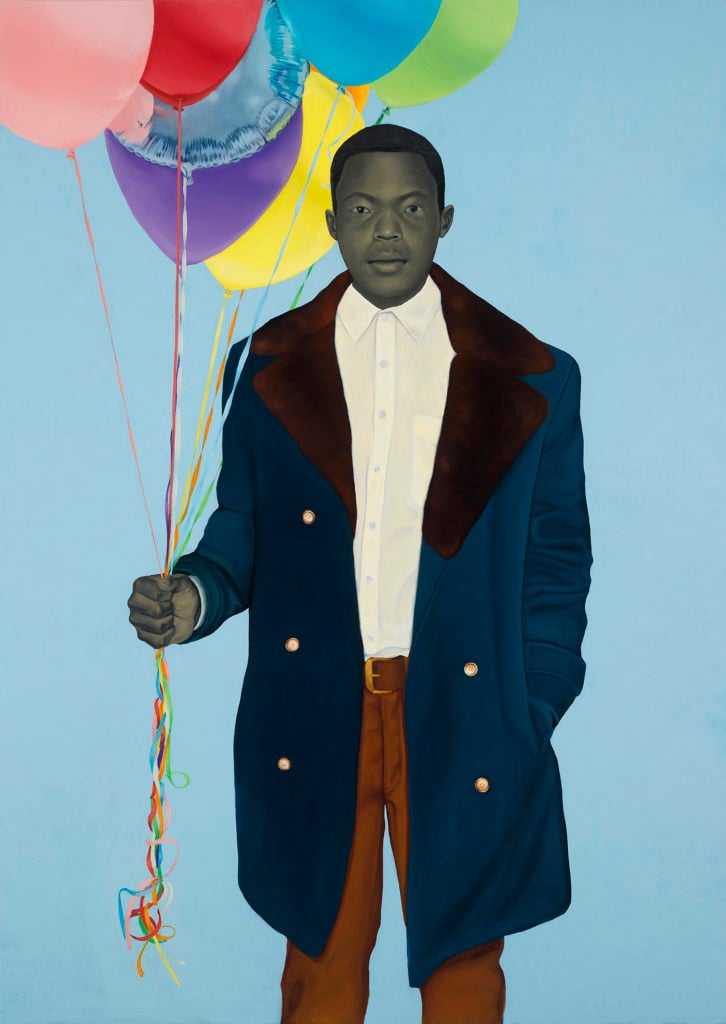
Amy Sherald, Pilgrimage of the Chameleon (2016). Courtesy of the artist and Hauser & Wirth, ©Amy Sherald.
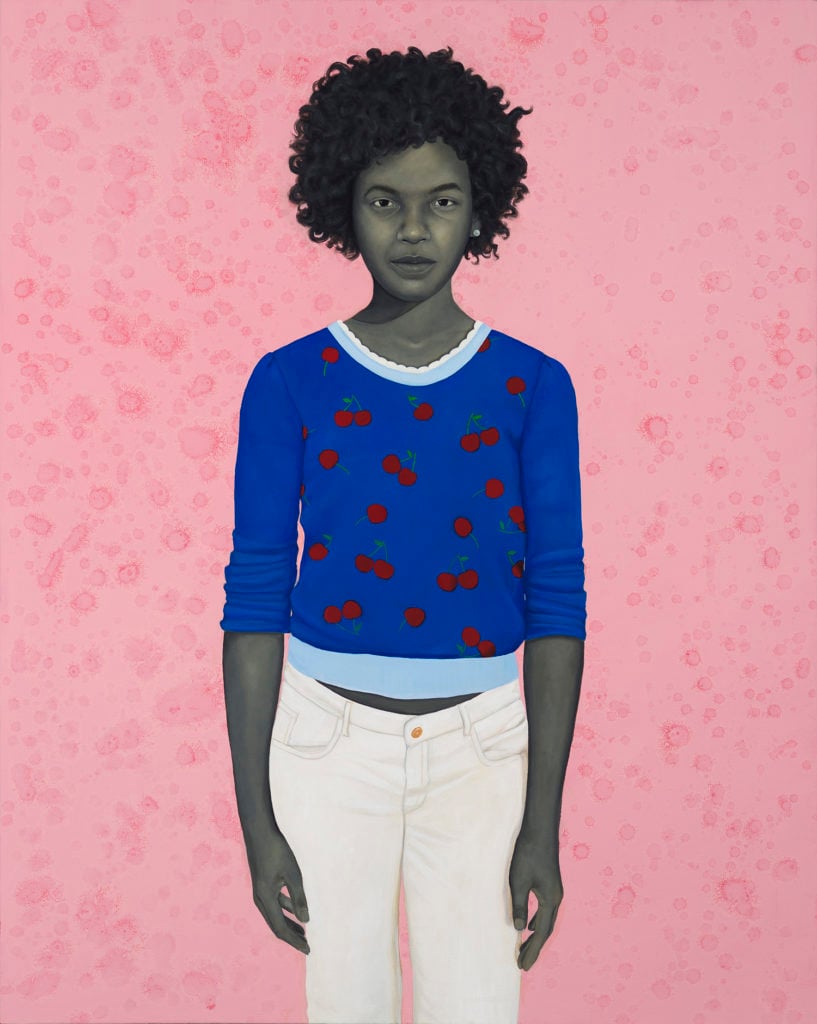
Amy Sherald, Light is easy to love. (2017). Courtesy of the artist and Hauser & Wirth, ©Amy Sherald.
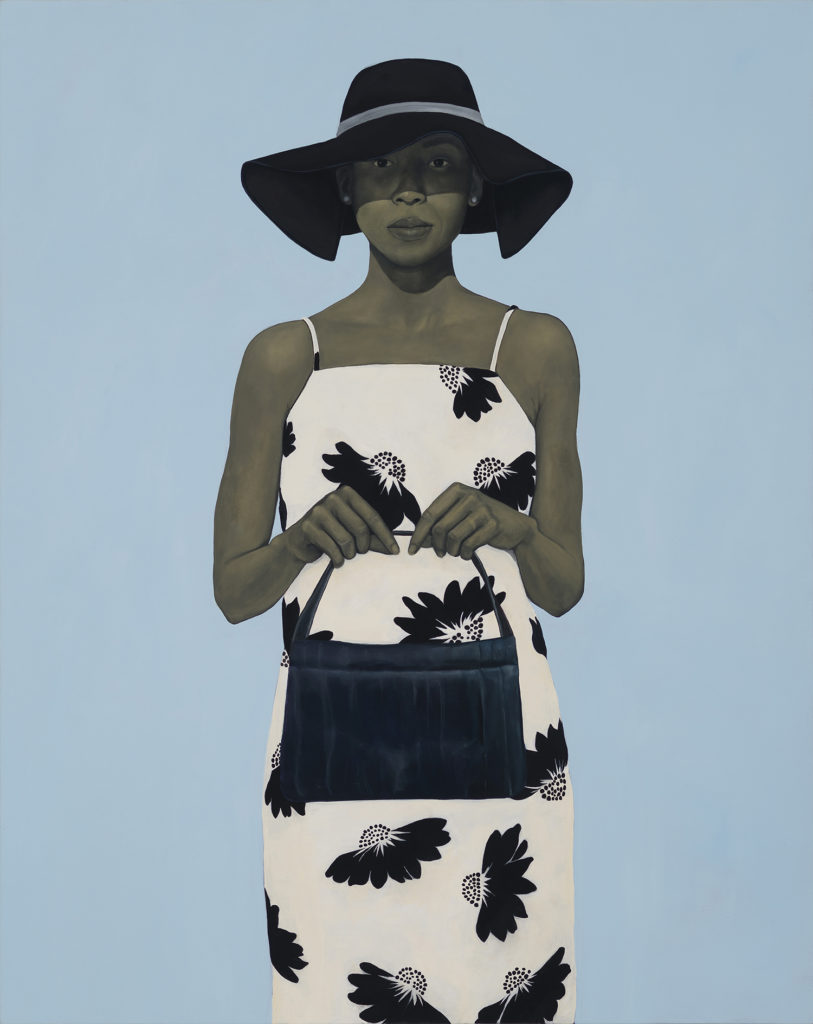
Amy Sherald, listen, you a wonder. you a city of a woman. you got a geography of your own. (2016). Courtesy of the artist and Hauser & Wirth, ©Amy Sherald.
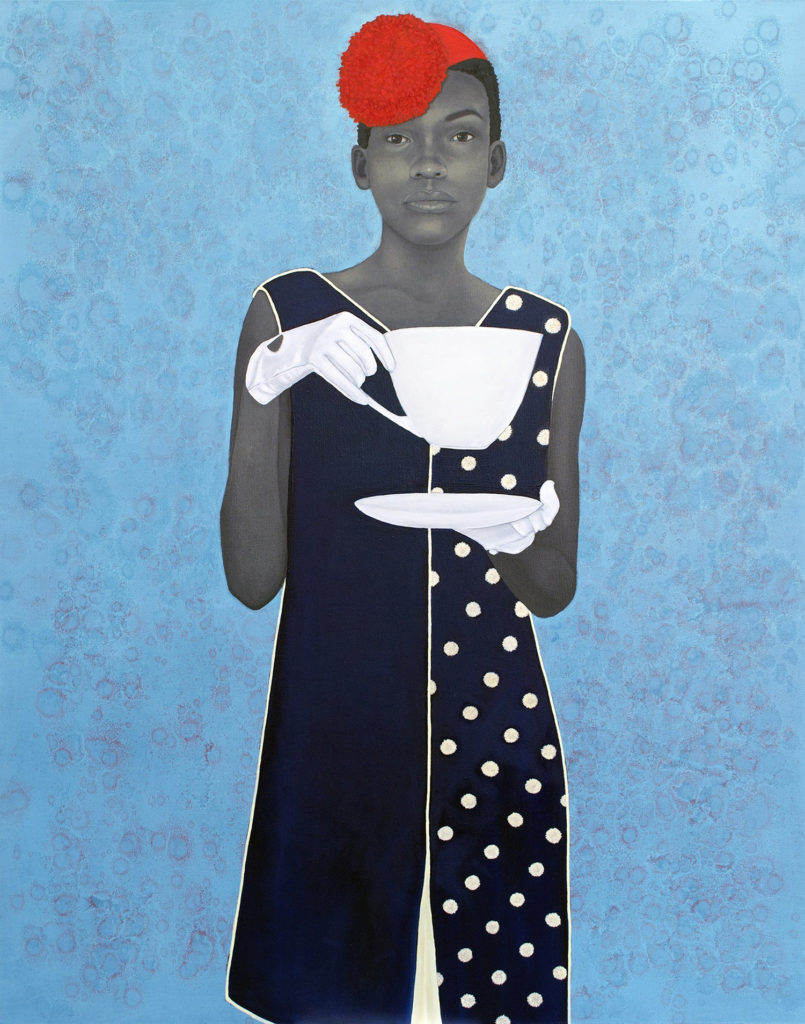
Amy Sherald, Miss Everything (Unsuppressed Deliverance), 2014. Courtesy of the artist and Hauser & Wirth, ©Amy Sherald.
“Amy Sherald” is on view at the Contemporary Art Museum, St. Louis, 3750 Washington Boulevard, St. Louis, May 11–August 19, 2018.
